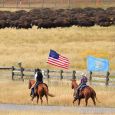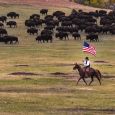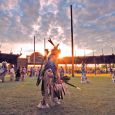The Gift of South Dakota
Subscriptions to South Dakota Magazine make great gifts!
Subscribe today — 1 year (6 issues) is just $29!
The Buffalo vs. the Bull
|
|
| Folks from both sides of the border gathered to watch the contest between Scotty Philip's buffalo and a Juarez fighting bull. |
There’s no one quite like a four-year-old for pondering the imponderable. My grandson Little Jack once asked me if a saber-toothed tiger could beat up a Tyrannosaurus rex. I told him I'd have to think about that, but I did know that a South Dakota buffalo could beat up four Mexican fighting bulls. At least that's what happened in Juarez, Mexico in 1907.
Scotty Philip, the well-known Stanley County cattleman and buffalo fancier, was in Texas on a fall buying trip and encountered a couple of sports from Juarez who were given to loud and repeated boastings about the stamina, fierceness, and fighting heart of the sharp-horned bulls they bred for combat in the bull rings of that country.
In response to this chauvinistic yammering, Philip politely suggested to the boastful Mexicans that he had, on his ranch, any number of ordinary buffalo that by damn could mop up the ring with the finest of those so-called fighting bulls. He furthermore offered to ship one or more of these buffalo to Juarez to prove his point and solidified his proposition with a substantial wager.
The Mexicans had seen only pictures of buffalo, and the prospect of one of the awkward, shaggy creatures challenging their fast-stepping, muscled beasts of destruction translated to them as an unprecedented opportunity for mucho dinero. Philip's sporting proposition was quickly joined, and arrangements were made for publicity and use of the Juarez bullring.
Unfortunately, a severe blizzard required Scotty Philip's presence on the ranch that January, so he was unable to make the trip to Mexico. In his stead, he dispatched his nephew, George Philip, to look after family interests and those of the local community, which had accumulated a sizeable pot to be wagered on behalf of the buffalo. Cowboys Eb Jones and Bob Yokum were sent along to tend the livestock.
From his ranch near Ft. Pierre, Scotty Philip selected two run-of-the-herd buffalo bulls, an eight-year-old and a four-year-old, for the contest. He called the older one Pierre; the name of the other isn't recorded — Murdo, perhaps. The bulls were loaded into a specially reinforced boxcar, and the entire party made the trip to El Paso and across the Rio Grande to Juarez in seven days, amidst a generous amount of en route hoopla due to the advance publicity and general interest in the outcome of the matchup.
 |
| Stanley County matadors? George Philip and fellow South Dakota businessmen posed in the ring after the famous fight. Photo from S.D. Historical Society. |
When they got the buffalo to the bullring on the designated Saturday, George Philip (according to his account of the trip in South Dakota Historical Review thirty years later) and company were surprised not only at the size of the facility, but at the number and fervor of the partisans from both sides of the border who had gathered for the spectacle.
When Pierre ambled out into the arena, the crowd emitted a buzz of anticipation. But the buzz became a groan as the shaggy bison reached the center of the ring and, tired from his long trip, calmly flopped himself down. Then there was a great reverberating roar as the Mexican bull was turned into the ring. Enraged by the darts that had been plunged into his shoulder to enhance his fighting spirit, the snorting, pawing bull launched himself at the unkempt mound in the middle of the arena like some 1,500 pound juggernaut from hell.
Pierre managed to get to his feet in time to take the bull's charge head-on. There was what sounded like an underground explosion, and the dust cleared to reveal the unmoved Pierre stoically contemplating a surprised and slightly dazed bundle of bovine bewilderment that had been bounced back a rod or so from the point of impact.
But the bull's momma hadn't raised any dummies; after all, hadn't he a pair of sharp horns that could slice this upstart's liver right out of his body? So he sidestepped to a position that gave a clear shot at the buffalo's uncovered flank, lowered his head and charged in for the vivisection.
Alas, the bull's momma hadn't told him about a major difference between bulls and buffalo; namely, that buffalo turn on their front, rather than rear, legs. This ability allowed Pierre to pivot at the last minute and once more absorb the bull's charge with his massive skull plate. And this time, the buffalo put some thrust behind powerful counter-blows.
After the final encounter had brought him to his knees, the once-fearsome fighting bull fled to the nether regions of the arena and tried to climb out of the ring. Failing that, he could only stand shaking as the catcalls and imprecations of the angry crowd rained down.
Claiming a fluke, the Mexican breeders called on George Philip to allow them to try one of their "best" bulls against the buffalo. Ever willing to go the extra mile, George agreed; and a fresh contender — sinewy and belligerent as the first bull — roared out of the corral directly at Pierre, who stood patiently at ring center. The outcome was the same as before: no matter from which direction the bull charged, he was met head-on.
This scenario was replayed that afternoon with yet two more bulls — and to the same end. By the time the sun had started to sink behind the stands, four battered and shaking Mexican fighting bulls huddled in the shadows by the west wall while the pride of Stanley County rolled contentedly on his back in the arena sand. George Philip offered the younger buffalo in combat the next day, but all the heart had gone out of the Mexican breeders, and they declined. For them the question had been settled, and they had no desire for any further decimation of their prize stock.
It would be nice to report that the buffalo were given heroes' welcomes back home; but because of transportation costs, they were sold in Juarez. One hopes they were used to enrich the fighting bull genetic strain, but the likelihood is that the burrito might have been replaced by the buffalito as the fast food mainstay in old Juarez for a time.
Later that year Mr. Scotty Philip founded the town that bears his name. His nephew, George, eventually became a respected lawyer in Rapid City. Eb Jones served as a Stanley County commissioner, and Bob Yokum has evidently been lost to history.
As I told my grandson, a South Dakota buffalo might have a struggle with old Tyrannosaurus rex, but I'm sure he'd give a sabre-toothed tiger all the fight he wants, and then some.
Editor's Note: The author, Jim Dickson, is a Sturgis native who currently lives in St. Paul, Minnesota. This story is revised from the March/April 1995 issue of South Dakota Magazine. To order a back issue or to subscribe, call 800-456-5117.











Comments
Your story settles the debate.